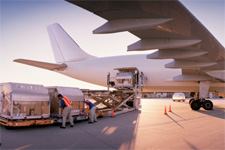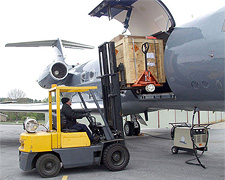TSA Implements First Milestone in Screening All Cargo on Passenger Planes
Air Cargo
 The Transportation Security Administration (TSA) has put in place procedures to meet the Congressionally-mandated requirement to screen 50 percent of all cargo on passenger planes by February 3, 2009.
The Transportation Security Administration (TSA) has put in place procedures to meet the Congressionally-mandated requirement to screen 50 percent of all cargo on passenger planes by February 3, 2009.
TSA has issued security directives to all air carriers requiring that they screen 50 percent of cargo placed on passenger aircraft. The directives became effective on February 1, 2009. Each air carrier is required to submit data monthly to TSA on the amount of cargo it has screened. TSA will verify compliance with its inspectors.
By implementing supply-chain-wide measures that include deploying TSA officers to screen the minimal amount of cargo at small airports from coast to coast and establishing protocols to certify manufacturers, indirect air carriers, cargo consolidators and others to screen goods and the airlines' existing screening protocols, TSA is addressing the important security concerns in the 9/11 Act while allowing the unimpeded flow of commerce.
Additionally, last October, TSA mandated screening of all cargo on narrow-body (one aisle) aircraft. These aircraft make up more than 95 percent of all U.S. flights on which more than 85 percent of all U.S. passengers travel each day.
 "Today, all cargo on a vast majority of flights in the U.S. is screened thanks to these important efforts," said Assistant Administrator John Sammon. "We will continue to expand these programs to meet the ultimate mandate of screening all cargo."
"Today, all cargo on a vast majority of flights in the U.S. is screened thanks to these important efforts," said Assistant Administrator John Sammon. "We will continue to expand these programs to meet the ultimate mandate of screening all cargo."
Toward this mandate, TSA also announced that more than 100 facilities have been certified as participants in the Certified Cargo Screening Program (CCSP) with more than 30 new companies being certified each week. When fully implemented, this public/private initiative will provide the critical supply-chain-wide ability to expand screening well beyond airline cargo warehouses to several points, including manufacturing facilities, consolidation points, distribution centers and independent cargo screening facilities (ICSF). ICSFs have the additional benefit of providing a cost effective avenue for small and medium-sized freight forwarders to meet the law's screening requirement. When fully implemented, this distributed screening effort will enable the estimated 12 million pounds of cargo loaded onboard passenger-carrying planes every day to be screened.
Certified CCSP facilities must successfully apply, participate and adhere to strict security standards, including physical access controls, personnel security, and screening of prospective employees and contractors to TSA standards. A secure chain of custody must also be established from the screening facility to the side of the aircraft.
During the implementation of these programs, TSA and the industry continue to utilize a multi-layered approach to air cargo security, including allowing only known and established shippers to offer cargo to passenger airlines for shipment, randomly screening a significant percentage of all cargo, deploying explosive detection canine teams at high volume cargo airports and conducting covert tests and no-notice inspections of cargo operations by hundreds of inspectors.


